Losing a limb means letting go of your favorite activities. Your daily movement is limited and furthermore, you cannot go on any adventure. The advent of prosthetics have made the lives of the handicapped more comfortable by allowing increased movement. You can walk slowly, hold light objects etc. but you cannot go hiking, paragliding, swimming by yourself. But what if you can?
DEKA has introduced a bionic arm that recently allowed a handicapped army veteran to do what common prosthetics would not- go rock climbing!
This mind-controlled robotic arm is named for Luke Skywalker’s lifelike prosthesis in Star Wars. The video shows that the arm is stable and provides a high level of control. Beside the minor slip of hand when grabbing onto the first rock, the vet is able to climb the rock wall with ease, if a bit more slowly than he previously could have.

How Does it Work?
The DEKA robotic arm was funded by the Defense Advanced Research Projects Agency (DARPA) and was developed by Dean Kamen. The arm uses electromyogram electrodes, which measure the electrical activity of muscles at rest and during contraction, to read signals sent by muscles to the arm and shoulder, as well as wireless sensors on the wearer’s feet. The arm that cost over $100 million and was the collaborative project of DARPA and Johns Hopkins University over the past five years, is controlled by a microchip in the brain. The microchip records neuron activity and decodes the signals to activate motor neurons controlling the arm. DEKA and DARPA are looking into mind control for future versions of the system, bringing us ever closer to having a bionic arm that functions as perfectly as Luke Skywalker’s bionic hand in the later parts of the “Star Wars” series.
Luke works much like a regular arm, with the ability to bend, rotate, and twist in 27 different ways. It is designed to restore almost complete hand and finger function to patients dealing with spinal cord injury, stroke, or amputation. It enables the person to control multiple joints, enable the wearer to have firmer grasp on an object and even control individual fingers on the hand. This means it can be used for things other prosthetics cannot, like using zipping and drinking from water bottles.

In 2014, FDA approved the DEKA prosthetic arm “Luke” for further experimentation and commercialization. Although the market release date is not announced yet, we can expect it in a couple of years.


